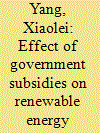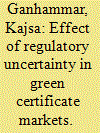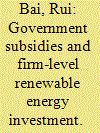|
|
|
Sort Order |
|
|
|
Items / Page
|
|
|
|
|
|
|
| Srl | Item |
| 1 |
ID:
167014


|
|
|
|
|
| Summary/Abstract |
By considering 92 renewable energy listed enterprises in China between 2007 and 2016 as sample, this paper constructs a panel threshold effect model to investigate the threshold effect of government subsidies on renewable energy investment and further explores the effects and differences regarding government subsidy types and enterprise size on the threshold effect. The results show that, first, government subsidies have a positive threshold effect on renewable energy investment of China. When energy consumption intensity and bank credit are greater and the level of economic development is less than the threshold value, the contribution of government subsidies to renewable energy investment is significantly enhanced. Second, monetary subsidies and tax incentive policies can promote renewable energy investment, but the effect of tax incentives is more significant. Third, government subsidies are the main force supporting the development of medium-, small-, and micro-sized renewable energy enterprises. On the basis of these results, the Chinese government should strengthen policy support in those areas with high economic costs of energy transition, encourage the investment in renewable energy in large-sized enterprises, play a policy-guiding role, and focus on strengthening subsidies for medium-, small-, and micro-sized enterprises.
|
|
|
|
|
|
|
|
|
|
|
|
|
|
|
|
| 2 |
ID:
181441


|
|
|
|
|
| Summary/Abstract |
European Commission favours market-based support policies, such as markets for tradable green certificates, to promote renewable energy. Meanwhile, these instruments have received critique for exposing investors to large price risk as the level of support is determined by the market price of certificates. Using a two-step procedure, this study builds upon the work of Fagiani and Hakvoort (2014) by firstly examining how regulatory interventions in the Swedish-Norwegian certificate market affect price volatility, focusing particularly on the period after Norway joined in 2012. The results show that interventions in the market exacerbate price risk by resulting in regimes of increased volatility. They indicate that, contrary to policymakers expectation, prices did not stabilise after the market integration with Norway. Employing a real options approach, the study further proceeds to demonstrate that price risk increases the threshold for immediate development of Swedish wind power projects; a one standard deviation increase in certificate price volatility is estimated to reduce the probability of project development by 12%. These findings illustrate that regulatory uncertainty in terms of high price volatility disrupts the investment climate in certificate markets, ultimately affecting cost-effectiveness of such policy.
|
|
|
|
|
|
|
|
|
|
|
|
|
|
|
|
| 3 |
ID:
181803


|
|
|
|
|
| Summary/Abstract |
Understanding the heterogeneity and influencing factors of renewable energy investment between enterprises can help to evaluate existing policies and provide guidance for future subsidy policies. This paper investigates how the relationship between government subsidies and renewable energy investment depends on enterprise size and relaxes the linear relationship in the traditional empirical model. Based on firm-level panel data from China, only when the enterprise size exceeds a certain threshold value can it have a significant effect. The effect of government subsidies on renewable energy investment is on the rise. However, its speed tends to decrease with the growth of enterprise size. Besides, ownership concentration and enterprise growth significantly promote investment in renewable energy. The empirical results show that the effect of government subsidies has a significant enhancement in 2016, which may be due to high frequency and high government subsidies in the early stage. These findings are robustly verified. Finally, some specific policy suggestions are put forward.
|
|
|
|
|
|
|
|
|
|
|
|
|
|
|
|
| 4 |
ID:
121273


|
|
|
|
|
| Publication |
2013.
|
| Summary/Abstract |
Developing nations are seeking alternative energy for electricity, and one attractive alternative is renewable energy. This research analyzes changing investment environment for renewable energy with real options approach, and explores its potential in developing economies through studying the case of Mongolia under coal price uncertainty. To evaluate comparative attractiveness of either continuing to use coal-based infrastructures or switching to renewable energy, we formulate social revenue functions for the two environments, assuming that renewable energy has lower external costs, and coal prices follow geometric Brownian motion (GBM) or geometric mean-reverting (GMR) processes. We find the optimal trigger coal prices for switching technologies with some scenarios in electricity price and externality; characterize when renewable energy investments become attractive. In contrast to conventional wisdom, we identify some situations where the value of having more decision opportunities does not exceed that of a now-or-never decision for switching technologies, and welfare losses are incurred. The optimal trigger prices are higher in GBM than in GMR, and our result raises the possible risks for waiting to switch energy. To avoid welfare losses in Mongolia, the government should increase electricity prices or switch to renewable energy earlier, especially when people pay more for the removal of externalities.
|
|
|
|
|
|
|
|
|
|
|
|
|
|
|
|
| 5 |
ID:
111063


|
|
|
|
|
| Publication |
2012.
|
| Summary/Abstract |
This paper uses transaction and index data to empirically examine price formation in, and equilibrium characteristics of, the primary CDM market. Results point to the preemptive (and, possibly, speculative) behaviour among intermediaries (carbon firms), and inefficiencies in information transmission between secondary and primary markets. Since the primary carbon market is unstable and is prone to rational and irrational oscillations, the CDM, in its current form, is not a reliable policy tool for long-term renewable energy sector development plans, whenever fiscal regulatory instruments are available.
|
|
|
|
|
|
|
|
|
|
|
|
|
|
|
|
| 6 |
ID:
150701


|
|
|
|
|
| Summary/Abstract |
Many countries have implemented various policies for renewable energy development ranging from setting power purchase agreements and the legislation of renewable energy requirements to providing incentives and imposing carbon taxes. The evaluation of the effectiveness of such policies, however, is fragmented, which raises a need for a comprehensive analysis. This paper aims to assess whether and how policies promoting renewable energy investment have achieved the intended goals. It employs five broadly defined criteria - market, uncertainty, profitability, technology, and financial resources - to build an index to assess respectively if such policies have helped create a market for renewable energy, maximize potential profits, reduce risks relating to the investment, develop and adopt new technologies, and improve the access to financial resources. Each criterion is reflected by three indicators. Values of each indicator are converted into ordinal values for analysis. The index not only scans comprehensively all relevant renewable energy investment policies in the East Asia Summit countries, but also provides systematic and quantitative measures to compare the effectiveness of policies in these countries with respect to the creation of market, the degree of uncertainty, the potential of profitability, the development and adoption of technology and the accessibility of financial resources.
|
|
|
|
|
|
|
|
|
|
|
|
|
|
|
|
|
|
|
|
|